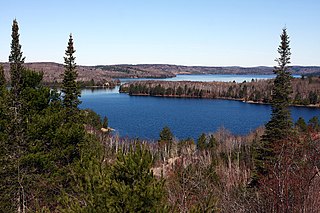
Elliot Lake is a city in Algoma District, Ontario, Canada. It is north of Lake Huron, midway between the cities of Sudbury and Sault Ste. Marie in the Northern Ontario region. Once dubbed the "uranium capital of the world," Elliot Lake has since diversified to a hub for advanced manufacturing, forest harvesting, mine reclamation expertise, retirement living, all-season tourism and remote work.

Denison Mines Corp. is a Canadian uranium exploration, development, and production company. Founded by Stephen B. Roman, and best known for its uranium mining in Blind River and Elliot Lake, it later diversified into coal, potash, and other projects.
Rio Algom was a mining corporation that was purchased by Billiton in 2000 and is now part of BHP.

Uranium mining in Utah, a state of the United States, has a history going back more than 100 years. Uranium mining started as a byproduct of vanadium mining about 1900, became a byproduct of radium mining about 1910, then back to a byproduct of vanadium when the radium price fell in the 1920s. Utah saw a uranium boom in the late 1940s and early 1950s, but uranium mining declined in the 1980s. Since 2001 there has been a revival of interest in uranium mining, as a result of higher uranium prices.
The Stanleigh Mine is an abandoned uranium mine located approximately 3 km northeast of Elliot Lake, Ontario, owned and operated by Rio Algom Ltd. The site has been rehabilitated and is currently undergoing environmental monitoring.
The Milliken Mine is an abandoned uranium mine located approximately 2.5 km northeast of Elliot Lake, Ontario, owned and operated by Rio Algom Ltd. The site has been rehabilitated and its tailings facility is currently undergoing environmental monitoring by Denison Environmental Services as part of the monitoring of the Stanleigh Mine and tailings facility.
The Panel Mine is an abandoned uranium mine located approximately 14.5 km northeast of Elliot Lake, Ontario, owned and operated by Rio Algom Ltd. The site has been rehabilitated and is currently undergoing environmental monitoring.
The Stanrock Mine is an historical uranium mine located approximately 11.5 km northeast of Elliot Lake, Ontario, owned by Denison Mines. The site has been decommissioned and rehabilitated with ongoing monitoring by Denison Environmental Services.
The Quirke Mine is an abandoned uranium mine located approximately 13.5 km north of Elliot Lake, Ontario, owned and operated by Rio Algom Ltd. The site has been rehabilitated and is currently undergoing environmental monitoring.
The Pronto Mine is an historical uranium mine located approximately 20 km south of Elliot Lake, Ontario near Spragge. The site is owned and operated by Rio Algom Ltd, has been rehabilitated and is currently undergoing environmental monitoring.

The Buckles Mine is an historical uranium mine located approximately 4.5 km southeast of Elliot Lake, Ontario, owned and operated by Rio Algom Ltd. The site has been rehabilitated. Environmental monitoring is ongoing as part of the monitoring for the nearby Nordic Mine.
The Can-Met Mine is an abandoned uranium mine located approximately 12.5 km northeast of Elliot Lake, Ontario, owned by Denison Mines Ltd. The site has been rehabilitated and its tailings facility is currently undergoing environmental monitoring by Denison Environmental Services.
The Nordic Mine, is an abandoned uranium mine in the Elliot Lake area of Ontario, owned by Rio Algom Ltd. The site has been rehabilitated and its tailings facility is currently undergoing environmental monitoring by Denison Environmental Services.
The Lacnor Mine, is an abandoned uranium mine in the Elliot Lake area of Ontario, owned by Rio Algom Ltd. The site has been rehabilitated and its tailings facility is currently undergoing environmental monitoring by Denison Environmental Services.
Consolidated Denison Mine, or the Denison Mine is an abandoned uranium mine located approximately 12.5 km north of Elliot Lake, Ontario. The site is bordered north by Pronto Mine, Quirke Mine and Nordic Mine; on the east by Panel Mine and Can-Met Mine; and south by Spanish American Mine and Stanrock Mine.

Canada is the world's second largest producer of uranium, behind Kazakhstan. In 2009, 20% of the world's primary uranium production came from mines in Canada. 14.5% of the world production came from one mine, McArthur River. Currently the only producing area in Canada is northern Saskatchewan, although other areas have had active mines in the past.

Uranium mining around Bancroft, Ontario, was conducted at four sites, beginning in the early 1950s and concluding by 1982. Bancroft was one of two major uranium-producing areas in Ontario, and one of seven in Canada, all located along the edge of the Canadian Shield. In the context of mining, the "Bancroft area" includes Haliburton, Hastings, and Renfrew counties, and all areas between Minden and Lake Clear. Activity in the mid-1950s was described by engineer A. S. Bayne in a 1977 report as the "greatest uranium prospecting rush in the world".
The Elliot Lake Miners Strike was a wildcat strike by approximately 1,000 uranium miners who worked at Denison uranium mine in the Elliot Lake area of Ontario, Canada. The strike was the first time that Canadian workers had taken industrial action over safety concerns, and it led to Ontario Premier Bill Davis creating a royal commission which led to the creation of new health and safety legislation.

Uranium mining in the Elliot Lake area represents one of two major uranium-producing areas in Ontario, and one of seven in Canada.

Quirke Lake is body of water located in Ontario, Canada. It is located in the Quirke Lake basin, a geological basin the northern part of the Huronian Supergroup. The lake is proximate to five decommissioned uranium mines.






